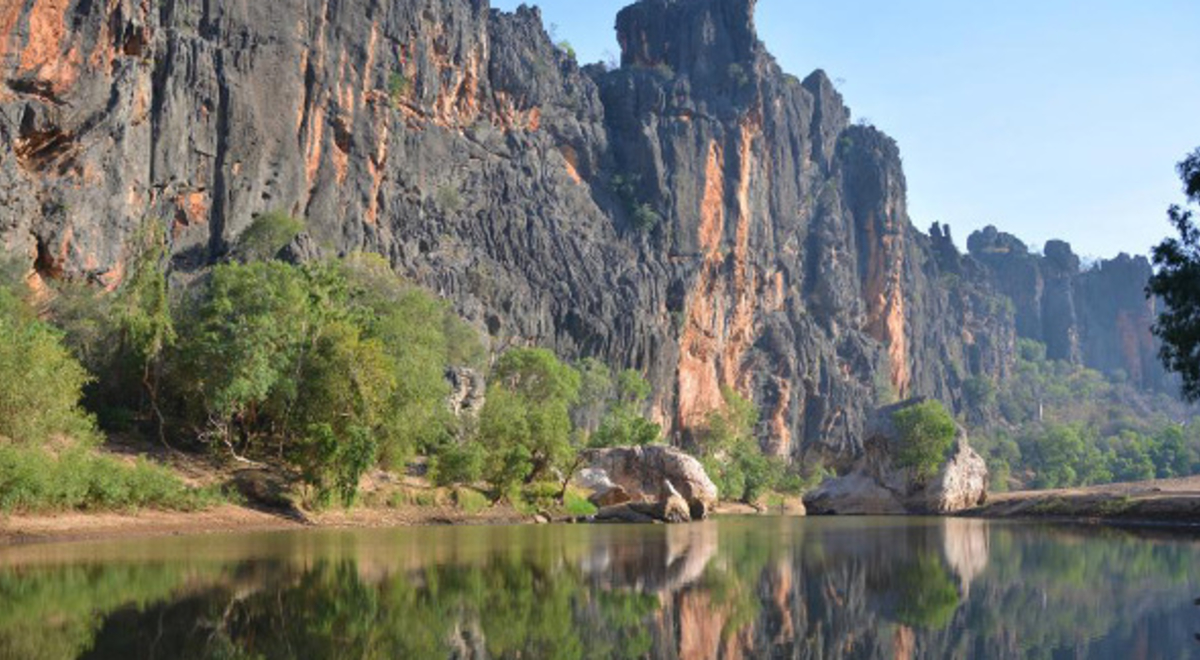Australia’s wide open spaces are home to spectacular natural sights that draw visitors from all around the world. Although there are plenty of native animals to see, today we're focusing on the natural landmarks created over millions of years.
From Western Australia to Queensland, take a look at our country's spectacular gorges, which are all worth visiting if you love the outdoors.
Here are five examples of what you can see and experience by venturing around the country.
Hancock Gorge
Karijini National Park, Western Australia
Karijini national park is Australia’s best-kept secret, conspicuously absent on the itineraries of both international backpackers and domestic 'grey nomads', and astonishingly unknown by many West Australians.
Karijini’s baked landscapes are more quintessentially Australian than anything even Baz Luhrmann could muster: at dusk the skies are a beautiful violet against the backdrop of scarlet sand and burnt-black trees.

By contrast, the plunging slot canyons that riddle the park are often shaded and cool even under the midday sun, meaning the geological kaleidoscope of Hancock gorge can be explored all day.
This moderately short trek still requires hikers to wade, swim and spider-walk between its narrow walls – rusty escarpments of burnished bricks, teetering like a forgotten game of Jenga – winding up with a splash in the cobalt-streaked grotto of the viridescent Kermits pool.
Dry off by basking in the sun-soaked natural amphitheatre on the return journey. Then head straight to the park’s equally stunning Weano and Joffre gorges, too.
Nitmiluk (Katherine) Gorge
Nitmiluk National Park, Northern Territory
Little red buoys bob innocuously along the Katherine river, anchored to the trees on its banks. When these floats are free of crocodile bite marks for 28 consecutive days, Nitmiluk gorge is opened to canoeists and swimmers.
The tour boat crews are likely to still give them a last-minute check to make sure no estuarine crocodiles have been using them as chew toys before letting you launch yourself into the water for a post-cruise dip after a morning spent inspecting the park’s ancient Jawoyn rock art (and rock wallabies) that adorn bluffs of billion-year-old sandstone.

Nitmiluk gorge consists of a network of 13 ravines that become interconnected by the Katherine river during the wet season.
It’s during this time that saltwater crocodiles ply its length, becoming stranded when the waters recede. Rangers bait and relocate the salties, and leave those gleaming floats – which are bizarrely irresistible to the crocs that mistake them for food – to signal that it’s safe for visitors to get out and explore from the water, a rare treat in rural NT.
The best time to visit, perhaps unsurprisingly, is the dry season, from May to September, when flooding, activity restrictions and, of course, salties are least likely. Although you could always take the helicopter tour at any time of year to see those beguiling beasts from above.
More adventures in the Kimberley. Adventures At El Questro Wilderness Park In The Kimberley
Experience the spirit of the Outback. 50 Shades Of Red: The Spiritual Outback
Carnarvon Gorge
Queensland
An art gallery featuring some of Australia’s finest indigenous works, a cavernous amphitheatre, a frescoed cathedral and a secluded swimming pool: the many-tentacled Carnarvon gorge may be way out in Queensland’s central highlands, but there’s almost as much going on here as in the state’s glitzy capital, Brisbane.
Even the rock art is under 24-hour video surveillance.

In contrast to the other gorges on our list, Carnarvon is lush and densely verdant, supporting a carpet of mosses, the world’s largest fern, waterfalls, turtles, swamp wallabies and platypuses. Carnarvon creek, which carved the 600-metre-deep gorge into the landscape, has run dry only twice since records began.
Accordingly it has a cooler climate than the surrounding terrain, which means you won’t be able to blame the swelter for not getting around all 22 kilometres of track in the eight-hour day the park guide pamphlet recommends.
However, it would be a shame not to take it slow and stay overnight to see one of the gorge’s five species of glider wafting between the treetops.
Windjana Gorge National Park
Western Australia
There’s a whiff of mysticism around Windjana gorge, which cuts through the Kimberley’s Napier range, part of a 350-million-year-old 'Great Barrier Reef' of the Devonian period.
Approach the wide canyon from along its sandy-bottomed centre and you are dazzled by glorious reflections of tiger-striped cliffs under azure skies, the seasonally fluctuating Lennard river providing a perfect mirror, occasionally rippled by the tail-flicks of dozing freshwater crocodiles.

Peek among the undergrowth and you’ll see magnificent nests, built by bowerbirds as a tunnel of twigs surrounded by a courtyard, elaborately decorated with bones and shells plucked from the limestone gorge walls.
Meanwhile the treetops teem with screeching corellas and fruit bats, the latter occasionally found desiccated among the branches, suspended in slumber.
Kings Canyon
Watarrka National Park, Northern Territory
No catalogue of the Australia’s best gorges would be complete without its most regal: Kings canyon.
Although its sylvan gorge-bottom walk would be suitable for all fitness levels, those with some more energy should strap on a pack and test their tickers with a hike up Heartbreak hill to the park’s drawcard: the canyon rim walk.

Up here you’ll realise just how young we all really are when confronted with ancient, honeycombed cliffs offering views across a landscape of immaculate isolation.
Striped, beehive domes – whittled by millennia of elemental erosion – crown these crags, while antediluvian marine fossils are etched into the 330-million-year-old sandstone.
Allow time to make the detour down to the canyon’s verdurous waterhole: lined by 400-year-old cycads that have scarcely evolved since the Jurassic period, this natural oasis is known as the 'Garden of Eden', which is kind of ironic given the prehistoric surroundings.
Visit your local Flight Centre store or call 131 600 for more advice and the latest deals.
This article originally appeared on guardian.co.uk
This article was written by James Draven from The Guardian and was legally licensed through the NewsCred publisher network.![]()


